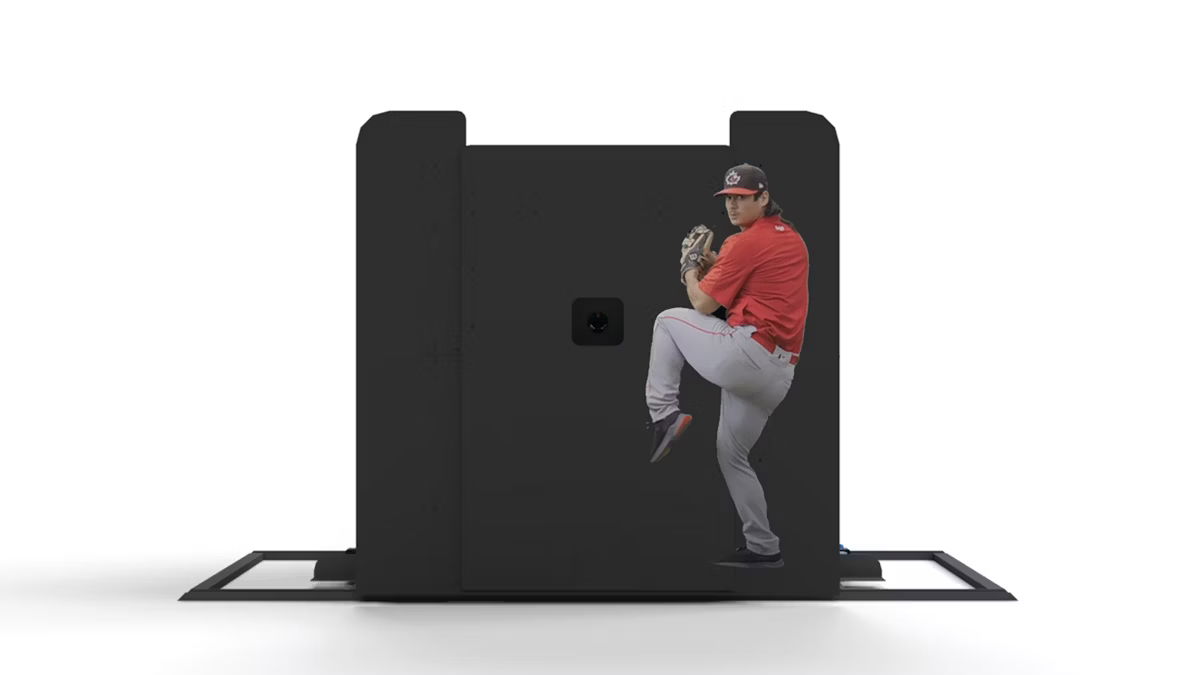

Hitters are facing increasingly dominant pitchers in Major League Baseball, with rising velocities and devastating breaking balls. Enter Trajekt Arc—a state-of-the-art pitching robot that replicates the exact windup and pitches of any MLB pitcher. Los Angeles Dodgers outfielder Jason Heyward calls it “helpful,” while Milwaukee Brewers’ Rhys Hoskins sees it as the “first big thing” in a wave of advancements for hitters. But what exactly makes Trajekt so revolutionary?
Watch What’s Trending Now!
Traditional batting practice with human pitchers has limitations in replicating the diversity and intensity of game situations; Trajekt offers a cutting-edge solution, allowing hitters to step into the virtual batter’s box against their upcoming opponents. Not only does this allow them to hone their timing—it also helps them perfect pitch recognition, with an enhancement of their decision-making skills as a bonus in a controlled environment—potentially translating to improved performance in live games. Heyward, a seasoned veteran, shares his experience using Trajekt to gain an edge over pitchers.
Evaluating a new technology’s effectiveness requires real-world feedback from professional athletes. Heyward, a seasoned veteran, shares his experience with Trajekt Arc, emphasizing its value in visualizing a pitcher’s repertoire and familiarizing oneself with their tendencies. His endorsement in the recent ESPN report adds credibility to Trajekt’s claims and suggests its potential impact on hitters’ preparation and performance. “Just getting a visual, an idea, of what someone has and how that may come out is cool. It’s helpful, for sure,” he remarked.
ADVERTISEMENT
New addition to @DrivelineBB – the ultra-precise Trajekt pitching machine.
Seam orientation. Release side and height. Overlay videos. Gyroscopic spin control. All robot controlled.
Only in Phoenix, AZ. pic.twitter.com/lSZIXttUix
— Kyle Boddy (@drivelinekyle) April 23, 2024
Predicting the future of technology in sports is always a gamble. Rhys Hoskins, who used Trajekt extensively during his injury recovery back in 2023, offered a glimpse into the future, envisioning even more advanced hitting technologies on the horizon: “There’s always ideas coming; it’s just, ‘How do you execute them?’ But this is a great start.” This insight sparks curiosity and anticipation for the next wave of innovation in baseball training and player development. But how exactly did Trajekt become a reality?
Turning a teenage dream into a successful business venture is a daunting task. Joshua Pope, Trajekt Sports’ CEO, pursued his vision relentlessly, transforming a high school debate into a multi-million dollar company that now serves nearly two-thirds of MLB teams. This entrepreneurial success story demonstrates the power of innovation and the potential impact of technology on professional sports. In just a few years, the Arc’s adoption has skyrocketed, highlighting its growing acceptance in the baseball community.
ADVERTISEMENT
Trajekt Arc aims to empower, not overpower, the sport as we know it
Introducing new technology to a sport with deeply rooted traditions often faces resistance. Trajekt’s rapid adoption in MLB, from a single team to a widespread phenomenon, signifies a shift in mindset and a growing acceptance of technological advancements in baseball. This widespread adoption indicates a recognition of the machine’s potential to enhance player development, game preparation, and ultimately, the overall quality of play. But does this mean the end of traditional batting practice?
ADVERTISEMENT
Top baseball sport companies combine to make the actual pitching robot, Trajekt Arc, it utilizes super-precise motor control, image processing, and machine learning to toss out perfect consistent pitches.#technolgy #pitching #robotics #realworld #sports #tech #baseball #apple pic.twitter.com/EWTfF9vbGr
— Discoveryflow+ (@discoveryflow) October 24, 2023
Assessing the long-term impact of a new technology requires data-driven analysis. Early data suggests a subtle decline in strikeout rates against relievers, potentially attributed to the robot’s role in improving hitters’ familiarity with pitch types and movements. While not definitive, this data offers a glimpse into Trajekt Arc’s potential to influence in-game outcomes and shift the balance of power between pitchers and hitters. However, Trajekt’s impact goes way beyond mere statistics.
The debate over the fairness of technology in sports is ongoing and complex. Trajekt sparks discussions about fair play versus unfair advantage, prompting a critical examination of the role of technology in maintaining a level playing field. This debate fuels further innovation and refinement of technologies like Trajekt, ensuring they enhance the sport without compromising its integrity. As a result, some pitchers have voiced concerns about the fairness of Trajekt, arguing that it gives hitters an unrealistic advantage.
ADVERTISEMENT
Maintaining the integrity and excitement of baseball while embracing technological advancements is a constant balancing act. Trajekt aims to strike this balance by empowering hitters with knowledge and insights, potentially leveling the playing field against increasingly dominant pitchers. This approach ensures that technology serves as a tool for enhancing the sport rather than overshadowing the skills and athleticism of the players. As Rhys Hoskins predicted, “For this to kind of be the first big thing obviously means there’s more coming.”
Top Stories
Ross Atkins Told to Act Fast on Kyle Tucker as Latest Contract Projection Ignites New Buzz

Padres Plot Dodgers Revenge With ‘Second Yoshinobu Yamamoto’ Heist As Jed Hoyer Loses Grip, Per Insider

Kyle Tucker Throws Blue Jays Into Chaos as Ross Atkins Forced Into Harsh Job Cuts

3 Players David Stearns & Mets Must Go After To Solve Pete Alonso Void

Bob Nutting Moves to Bolster Paul Skenes as Pirates Circle $7.7M Red Sox Veteran, Per Insider

The future of baseball is uncertain, but technology will undoubtedly play a significant role. Trajekt Arc’s emergence as the ‘first big thing for hitters’ definitely signals a new era in hitting, where technology empowers players and shapes the evolution of the sport. As Trajekt continues to evolve and inspire further innovation, baseball fans can anticipate a future where technology and human skill coexist, pushing the boundaries of what’s possible on the field. Will Trajekt revolutionize baseball as we know it, or is it just a fad? Only time holds the answer.
ADVERTISEMENT
ADVERTISEMENT
ADVERTISEMENT

